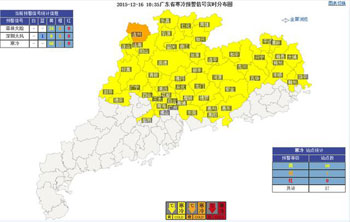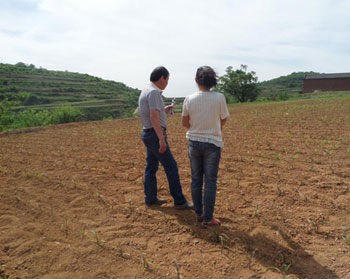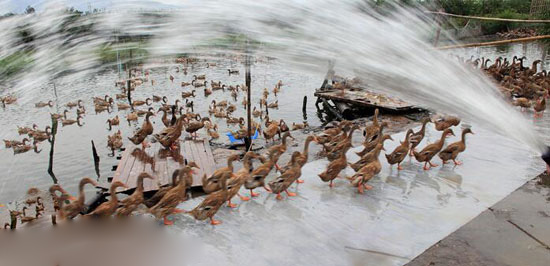Typhoon Jasmine became even more fierce after the cold wave in Guangdong.
Original title: 57 cities and counties in Guangdong issued a cold warning tomorrow and the Pearl River Delta has a minimum of 4-10 ℃
Affected by the cold air, 57 cities and counties in Guangdong have issued cold warning signals. The Guangdong Provincial Meteorological Bureau predicts that the cold air will continue to replenish the impact from the 17th to the 19th, with sunny, cold and dry parts of Guangdong, low temperatures of 2 to 5 ℃ in most cities and counties in northern Guangdong, frost and local freezing in alpine areas. In addition, Typhoon "Jasmine" enters the southern part of the South China Sea and the sea surface is stormy.
At 17:33 yesterday (15th), the Guangzhou Meteorological Bureau issued a cold yellow warning signal since the beginning of winter this year, reminding the public to guard against cold and keep warm. As of 10:35 on the 16th, a total of 56 cold yellow warning signals in Guangdong (the daily average temperature remained below 12 ℃) were in force, and Lianzhou in northern Guangdong issued an orange warning signal (the minimum temperature will drop below 5 ℃).

Distribution map of cold early warning signal in Guangdong at 10:35 on December 16th
This year's 27th Typhoon "Molly" (Taiwan wind level) at 8 am on the 16th, located 155 kilometers south-west of Manila, Philippines, near the center of the maximum wind force 13 (38 meters per second).
Cold air is high pressure, typhoon is low pressure, as the saying goes, water flows low, and the wind blows from high pressure to low pressure. Under the guidance of Typhoon "Jasmine", from 16 to 17, there were 8 to 9 gusts and 10 gales in the Taiwan Strait, the northeastern South China Sea and the Bashi Strait, and 6 to 8 winds in the coastal waters of Guangdong.
Chart of surface wind field at 10:40 on December 16th
Affected by the wind and waves on the sea, flights to and from the islands at Zhuhai Xiangzhou Wharf were suspended on December 16. It is expected that the intensity of "jasmine" gradually weakens and has no direct impact on our country.
Specific forecast:
On the 16th, it was cloudy in the cities and counties of western Guangdong, and the sunny days were mainly in other cities and counties.
On the 17th, the weather was generally fine in most cities and counties in northern Guangdong. In the morning, there was a low temperature of 2: 5 ℃ in cities and counties in northern Guangdong, and 1: 2 ℃ in alpine areas with frost. The lowest temperature distribution is 2: 6 ℃ in cities and counties in northern Guangdong, 4: 10 ℃ in cities and counties in the Pearl River Delta, and 6: 11 ℃ in other cities and counties.
On the 18th, the weather was generally fine in most cities and counties in northern Guangdong, with a low temperature of about 1: 4 ℃ in the morning in most cities and counties in northern Guangdong, frost and local freezing in alpine mountains, and about 5 ℃ in cities and counties in the northern Pearl River Delta and northeastern Guangdong. The minimum temperature distribution is 1: 5 ℃ in cities and counties in northern Guangdong, 4: 10 ℃ in cities and counties in the Pearl River Delta, and 6: 11 ℃ in other cities and counties.
On the 19th, it was sunny to cloudy in the south, while the weather was generally fine in other cities and counties. In the morning, the low temperature was 3 ℃ in most cities and counties in northern Guangdong, 2 ℃ in alpine mountains, frost, and 5 ℃ in cities and counties in northern Pearl River Delta, 3 ℃ in most cities and counties in the Pearl River Delta, and 6 ℃ in other cities and counties.
Weather forecast for some cities in the Pearl River Delta in the next three days
Agricultural advice
According to the hint of China Xingnong Network, the rain and snow are fading away, and the sunny and cold weather has been spread out in most areas. for this reason, the following suggestions are given for growing vegetables:
1. Strengthen the coverage, keep warm and prevent frost. Open-field vegetables can be covered with rice straw or sunshade net, plastic film, etc., to block frost, increase ground temperature and prevent frost damage. Such as lettuce, spinach, cabbage moss, red cabbage moss, celery, garlic, spring cabbage, Chinese cabbage and so on covered by greenhouse film or sunshade net.
2. In the greenhouse vegetable production, one is to strengthen the greenhouse, prevent the strong wind from lifting the film, remove the snow in time, and prevent the greenhouse from collapsing under the pressure of snow. Second, a small arch shed can be added in the greenhouse, covering the film at night, and covering the grass on the film. Plastic film is added to the foot of the greenhouse skirt as an apron to reduce the invasion of cold air at the bottom. Third, electric lights can be installed in the shed, in the case of weak snow and sky light, turn on the lights for about 3 hours in the morning and evening, in order to improve the temperature in the greenhouse and promote the photosynthesis of vegetable plants. Fourth, the use of carbendazim, chlorothalonil aerosol to prevent the occurrence of diseases. Fifth, after the weather is fine, take the method of covering the flower curtain, and let it out again and again, and then slowly heat up to restore normal growth to prevent flash seedlings caused by rapid heating up of strong light.
3. Fertilizing and cultivating soil to improve soil temperature. On sunny days, warm fertilizers such as cattle, pig manure or compost were applied to the rhizosphere of vegetables to increase the soil temperature. 2. 3 ℃. At the same time, combined with ploughing before freezing, the chopped soil can not only loosen the soil, but also directly protect the root system, and the suitable depth of intertillage is 7 cm-10 cm.
4. Clear the trench box to prevent waterlogging damage. For low-lying vegetable fields with water stains, it is necessary to ensure that the ditches are smooth. After rainy and snowy days, snow should be cleared in time, ditch boxes should be cleared, stagnant water should be removed, and a large amount of heat should be absorbed during melting to reduce the temperature, so as to improve root activity.
5. Control nitrogen and spread ash to improve cold resistance. Before the arrival of low temperature and freezing injury, sprinkling a layer of plant ash on the vegetable ground can not only prevent cold and frost, but also increase nutrients, but also has a better control effect on the root rot of cruciferous vegetables.
6. Set up wind barriers to block the cold wind. In the north of the vegetable field, crop straw is used to form a 1.5-meter-high wind barrier to prevent the cold wind from directly attacking the vegetables and reduce the freezing injury.
- Prev

How to interpret the industrialization of agricultural development is controversial.
How to interpret the industrialization of agricultural development is controversial.
- Next

The Muscovy Duck raised in the autumn harvest rice field is excellent in killing insects and weeds.
The Muscovy Duck raised in the autumn harvest rice field is excellent in killing insects and weeds.
Related
- A course of planting techniques and methods on how to grow carrots
- How to plant the latest tulips?
- Is it better to pick tea in the morning or in the afternoon? When is the best time for tea to be picked? what is the third or fifth tea?
- Launch Yuanxiao Happy combination Haocha + Tea Yuan healthy Taste
- Penghu Tourism "Fireworks 20 Parade with You"
- 2022 West Lake Happiness holds "Digital Revitalization Voucher" and draws iphone13 and laptop.
- Banqiao Fuzhou social houses are designed to change start-up combined with police elimination to create a safe and livable environment
- The convenient measure of "mechanical weeding" in Xinbei has been abused and the Agriculture Bureau has imposed heavy penalties on the illegal land consolidation.
- Changgeng University Joins Hands with Four Memory Factories to Rescue Memory Talent Shortage
- The list of Taiwan's top 100 MVP managers is listed by the Director-General of the Farmers' Association of Sanxia District.

